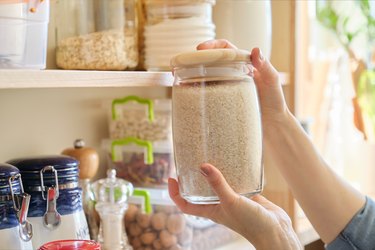
Do you find yourself throwing away food often? If so, FIFO — which stands for "first in, first out" — is something you'll want to get closer to.
If you've overdone it at the grocery store and are facing pantry shelves full of beans and grains, a freezer stocked with frozen veggies and meats and a fridge packed to the brim with anything else you could get your hands on, you might be panicking about what you're actually going to do with all of this food.
Video of the Day
Video of the Day
Keeping an over-stocked kitchen organized is key when it comes to keeping foods fresh and limiting food waste. So, how do you do that? The FIFO method will set you up with a process for moving foods in and out of your kitchen.
Here are the steps:
1. Combine like things with like things. Canned beans in your pantry go with other canned beans and canned foods. All of the yogurts in your fridge should be pulled together in one section. The same goes for the dry grains and oils in your pantry, cheeses in your fridge and meats in the freezer.
2. Place items with the soonest expiration in front. Next, look at the expiration dates on all of the items within each category. Place the items that are going to expire first towards the front of the refrigerator, freezer or shelf.
3. Keep newer items in the back. Stock items with a later expiration date towards the back behind the products with earlier expiration dates.
4. Always pull from the front. Finally, make sure when you're preparing a meal or looking for a snack that you're always pulling from the front of the pile. This way, older items will be used up first and items with more time will sit on the shelves
5. Keep FIFO going. As you continue to shop for food, pull older food forward, making room in the back for the newer food just purchased. Just make sure the expiration dates fall in order (they should, but this isn't always the case).
Find out the best way to store fruits and vegetables to stay fresh for longer.
Understanding Your Foods' Expiration Dates
Expiration dates are at the heart of the FIFO method and they can be tricky because they're not always black and white.
In fact, they can be downright baffling — a majority of adults are confused by the various food date labels, according to a September 2013 report put out by the National Resources Defense Council.
Here's a little refresher from the USDA Food Safety and Inspection Service on how foods are date-labeled before you implement FIFO at home:
- Best if Used By/Before: This date refers to when the food product will boast the best flavor or quality. Note that it's not a purchase or safety date.
- Sell-By: This date tells the store how long the product can be displayed. It's used for inventory management and is not a safety date.
- Use-By: This date tells us the last date recommended for use while the product is at peak quality. It is not a safety date unless it's on an infant formula product.
- Freeze-By: This date indicates when a product should be frozen so that it maintains top quality. It is not a safety or a purchase date.
You'll notice that aside from infant formula, date labels do not refer to safety but rather quality. The USDA stresses that if the date passes while you're storing at home, a product should still be safe to eat, if handled properly. But as with any food, don't just go by the date printed on the label: Use your eyes, nose and taste to tell you whether you should dine on it or ditch it.
When to Throw Something Out
Spoiled foods will "develop an off odor, flavor or texture due to naturally occurring spoilage bacteria," according to the USDA, in which case, they should not be consumed. When in doubt, throw it out.